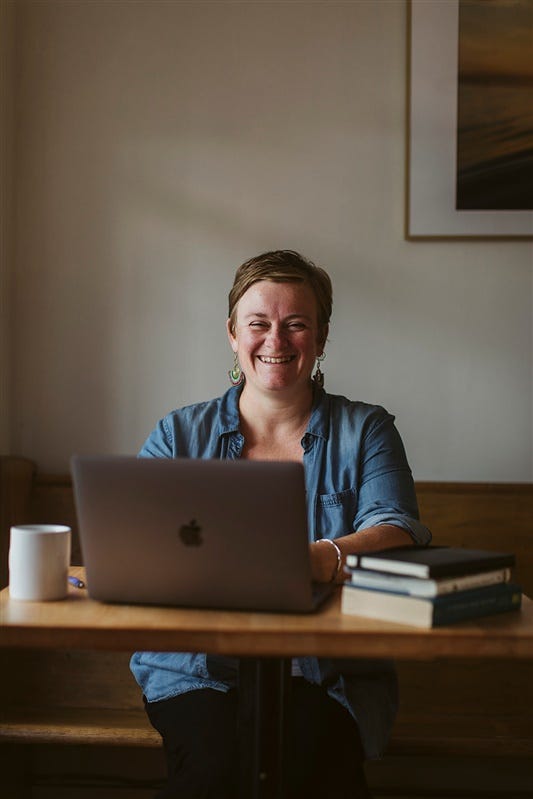Off the Page: Featuring Jessie Harrold
"Sharing my work and words is not just my dream-come-true: it’s my responsibility."
For over two decades, I have supported writers as an editor, publicist, and mindfulness-based book coach at various publishing houses, universities, corporations, and organizations. Through this journey, I’ve discovered that the quality of a writing life extends far beyond merely putting words on a page. It encompasses all the activities we engage in when we’re not writing. This insight inspired me to create Off the Page: Conversations About Writing as a Practice, where I feature writers sharing their diverse routines—from yoga and meditation to walking, reading, and even Olympic weightlifting. There’s no one-size-fits-all approach to writing, and there are as many ways to forge a writing life as there are humans on the planet.
This week, I’m thrilled to spotlight Jessie Harrold, a cherished member of the Narrative Healing community and a writer I deeply admire. Jessie is the author of Mothershift: Reclaiming Motherhood as a Rite of Passage (Shambhala, 2024).
About: Jessie Harrold is a coach and doula who has been supporting women through radical life transformations and other rites of passage for over fifteen years. She works one-on-one with women and mothers, facilitates mentorship programs, women’s circles and rituals, and hosts retreats and nature-based experiences. Jessie is the author of Mothershift: Reclaiming Motherhood as a Rite of Passage (Shambhala 2024) and Project Body Love: my quest to love my body and the surprising truth I found instead. She is also the host of The Becoming Podcast. Jessie lives on the east coast of Canada where she mothers her two children, writes, and stewards the land.
Lisa Weinert (LW): How is writing a healing practice?
Jessie Harrold (JH): Writing has always been a profoundly healing experience for me. I think, ultimately, it gives me the opportunity to explore the story of my life in ways that feel agentic. Through writing, I can bear witness to my own life – I can name, validate, celebrate or grieve what I’m experiencing. I can write about how also-beautiful the hard parts are, or how also-painful the wonderful things are. Often, on the page, I can choose the narrative I want to uphold in my life, long after I’ve blown out the candle and completed my morning writing ritual. And now, as I publish my second book, Mothershift, I’m seeing once again how the act of putting words to the human experiences that are so often unnamed in our culture is healing for the collective.
LW: What is the difference between “traditional writing” and “writing with a healing intention?:
JH: I think there are so many ways to answer this question, but for me, when my intention is healing, I write directly to my reader (or to myself!). I think, sometimes, that there is a wiser version of myself that I channel when I am writing in this way. I imagine she has a deeper, sturdier voice than I have, and she says “oh honey” and “it’s okay” in a way that feels reassuring and grounding. And no matter what advice or idea she may be offering up, at the heart of it is usually an invitation to widen the aperture on the challenges you’re facing so that you can also see the places in your life where there is ease and beauty and possibility.
LW: What role does movement play in your writing life? Do you return to any somatic practices, mindfulness exercises, or other rituals before or after you write?
JH: I walk in the woods or in the pre-dawn dark several times a week, and it’s increasingly become a necessary part of my writing practice. Movement allows me to access a different mental and emotional terrain from which new ideas and words can connect. I’m also endlessly inspired and supported by the more-than-human beings I meet on my walks. I almost always return with my head and heart full of ideas and sometimes even sentences or poems that have emerged along the way.
LW: How has sharing your work changed your life?
JH: I’ve always known that writing was the gift I landed here in this lifetime with, but it’s only been in the past ten years or so that I’ve learned the power of offering that gift up to others. Sharing my work and words is not just my dream-come-true: it’s my responsibility. It’s an act of reciprocity for the gift of having found such ease and joy in stringing words together. There are a lot of ways I can and will have an impact on the world around me, but writing is what I came here to do.
LW: What writers have influenced you the most?
JH: So, so many! But the one who has and continues to influence me most is Mary Oliver. I consider her a beloved ancestor, and I have a picture of her on my writing desk, alongside a little seashell filled with coffee beans as an offering to her memory. I think we would have been friends, given the chance, but in lieu, I talk to her on my walks and I read her poetry regularly. We share a similar relationship with the natural world and an insatiable curiosity about the numinous, and she reminds me that writing about beauty is an important medicine for our times.
LW: What book are you excited to read next?
JH: There’s a few! I’m currently reading Kerri ni Dochartaigh’s brilliant book Thin Places, and so I want to read her next one, Cacophony of Bone. I want to listen to Robin Wall Kimmerer narrate her new book, The Serviceberry: Abundance and Reciprocity in the Natural World because her voice is so soothing to me! And I can’t wait to read Moon of the Crusted Snow by Waubgeshig Rice – adding that to my overflowing TBR pile as well!







Thank you so much for this lovely feature, Lisa!! I appreciate you and all your support!
Another beautiful conversation Lisa, thank you for sharing it. 💕
I loved Jessie's book recommendations in particular. I read Kerri ni Dochartaigh’s first book, Thin Places, but hadn't gotten around to her second. Thank you for the reminder to seek it out!